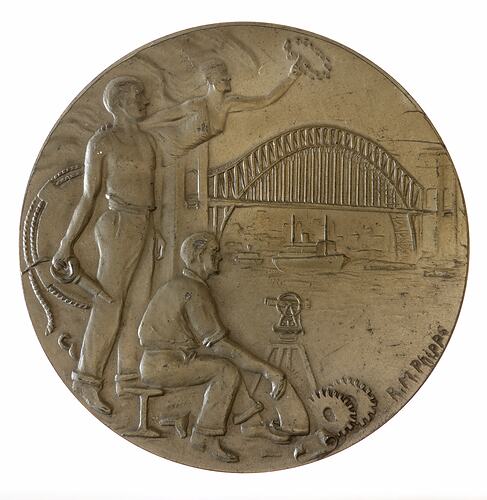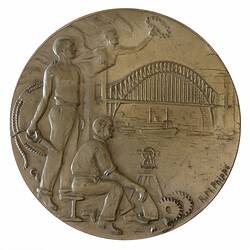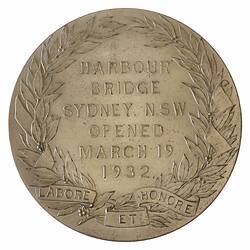Summary
Australia New South Wales Sydney
Opening of Sydney Harbour Bridge 1932 (AD)
Mint: Angus & Coote
Other Details: This medal was issued to commemorate the opening of the Sydney Harbour Bridge on 19 March 1932. It was designed by Rose M. Phipps. The idea of a bridge linking the northern and southern shores of Sydney Harbour had been suggested as early as 1815, but it was not until 1924 that the contract for the construction of the Bridge was let. The Bridge was designed and realised by J.J.C. Bradfield, a senior engineer who worked for the Department of Public Works. The Bridge became an icon of hope - and a major employer - during the Depression, and opening celebrations were lavish. Between 300,000 and 1,000,000 people participated in the festivities, including decorated floats, marching groups and bands, a gun-salute, a procession of passenger ships under the Bridge and a Venetian Canival. After the pageant members of the public were allowed to walk across the deck. At least eight medals were issued to commemorate its opening.
Obverse Description
In backround Sydney Harbour Bridge with ship steaming under it, Victory flying right above and crowning bridge with wreath; in foreground Engineer seated and behind him standing, a worker holding rivet gun in right hand tools and gears around, artist's name, R.M. PHIPPS incuse in field at right.
Reverse Description
Enclosed within wreath, HARBOUR / BRIDGE /S YDNEY. N.S.W / OPENED / MARCH 19 / 1932 on ribbon at base of wreath, LABORE ET HONORE
Edge Description
Plain
Significance
The Sydney Harbour Bridge is the world's largest (but not longest) steel arch bridge. Its total length including approach spans is 1149 metres and its arch span is 503 metres. The top of the arch is 134 metres above sea level. The total steelwork weighs 52,800 tonnes, including 39,000 tonnes in the arch. The 49-metre wide deck makes Sydney Harbour Bridge the widest Longspan Bridge in the world.
The idea of a bridge linking the northern and southern shores of Sydney Harbour was suggested as early as 1815 by former convict turned Government Architect Francis Greenway. Numerous proposals were discussed during the nineteenth century, including a suggestion by a naval architect in 1840 to construct a floating bridge. Other suggestions included a truss bridge in 1879 and in 1880 a high-level bridge.
Sydney engineer Peter Henderson drew one of the earliest known renditions of a bridge, around 1857. The 'father' of the Bridge, though, is considered to be J.J.C. Bradfield, a senior engineer who worked for the Department of Public Works. Bradfield's his vision, enthusiasm, expertise and supervision of all aspects of its construction finally realised the dream.
Bradfield developed the full specifications and scheme to finance the construction of a cantilever bridge, although the Legislative Council rejected the idea since the money could be better used to fight World War I. Bradfield became convinced that tenders should be called for both cantilever and arch designs, and in 1922 the necessary Act was finally passed in 1922 - the Sydney Harbour Bridge Act No. 28 - for the construction of a high-level cantilever or arch bridge across Sydney Harbour by connecting Dawes Point with Milson's Point. The Act also provided for the construction of electric railway lines.
In 1924 the construction contract was awarded to the English firm Dorman Long & Co of Middlesbrough, England, with a design for an arch bridge. The arch design was not only cheaper than the cantilever and suspension proposals but was also more rigid, and was therefore better fitted for the heavy loads.
Construction began in July 1923, and the two arches met at the centre of the span in August 1930. Premier Jack Lang opened the Harbour Bridge on the 19 March 1932. Francis Edward de Groot, a member of the New Guard, disrupted the opening ceremony when he slashed the ceremonial ribbon before the Premier was able to officially open the bridge.
The Bridge was an icon of hope - and a major employer - during the Depression, and opening celebrations were lavish. Between 300,000 and 1,000,000 people participated in the festivities, including decorated floats, marching groups and bands, a gun-salute, a procession of passenger ships under the Bridge and a Venetian Canival. After the pageant members of the public were allowed to walk across the deck.
-State Records of NSW web site http://www.records.nsw.gov.au/publications/aibs/037/page02.htm; Bridge Climb web site http://www.bridgeclimb.com. -D. Tout-Smith 15/10/2003.
More Information
-
Collecting Areas
-
Acquisition Information
Transfer from National Gallery of Victoria (NGV), 15 Mar 1976
-
Date Issued
1932 AD
-
Issued By
-
Mint
-
Artist
-
Inscriptions
Plain (edge) R.M.PHIPPS up r. side; Harbour Bridge in the background, three figure s at the side: winged Victory? with wreath, and two men (obverse) HARBOUR/BRIDGE/SYDNEY. N.S.W/OPENED/MARCH 19/1932 Wreath encloses the above inscription (reverse)
-
Series
-
Material
Silver
-
Axis
12
-
Classification
-
Category
-
Discipline
-
Type of item
-
Dimensions
63 mm (Outside Diameter), 99.91 g (Weight)
-
Shape
Round
-
References
Car 1932/7
-
Keywords


